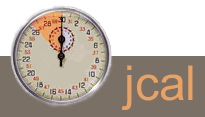

The purpose of this document is to get you up and running within minutes. I assume that you already have a servlet container, preferably Tomcat, and a database, preferably MySQL, up and running.
You can download a ...
binary version from here. Just drop the file in the 'webapp' directory of your servlet container.
If you'd rather build from source, you can get a source distribution from here.
The database needs to be configured in the file 'jcal/WEB-INF/classes/applicationContext.xml'. Create a database named 'jcal' or however you choose to name it. The tables will be set up automagically, the first time you fire up the application. If you want to use another database than MySQL remember to set the dialect property accordingly.
The jdbc driver is required by the container. If you use MySQL move the 'mysql-connector-java-3.0.8-stable-bin.jar' to the 'tomcat/common/lib' directory, or whatever is appropriate for your servlet container. The supplied driver is recommended to be used with MySQL Version 3.23. If you intend to use MySQL 4, get the latest driver here. If you use another database find the appropriate driver instead.
The following applies to Tomcat. Apply the appropriate steps for your servlet container.
To add and view events you need to authenticate yourself. The webapplication has been configured for the UserDatabaseRealm. Find 'tomcat/conf/tomcat-users.xml'. Add a new role named 'ical'. Add a new user with the 'ical' role.
Hint: you can finetune security rights by changing the struts action paths in 'struts-config.xml'
'/s/' means secure.
'/o/' means unsecure.
Start your webapplication server. jcal will be available at http://localhost:8080/jcal.
Before you can create an event, you must create a calendar and then select it, by clicking its name in the list.
enjoy!
jcal is built using Maven. Maven is one cool project managemant tool giving you just about any feature you could ask for (like generating this handy documentation site). In case you dwell under a rock and want to learn more do so here.
Get it.
Install it.
Open your shell (DOS), change to the project directory and type 'maven'.
Maven will download most of the required libraries. However you need to get some of them yourself. Maven keeps a repository of libraries on your computer. You can find it at '~/.maven/repository/'. You can find the libraries on the net, or extract them from the binary distribution. Unpack them here.
Retype 'maven' and watch Maven do the magic.